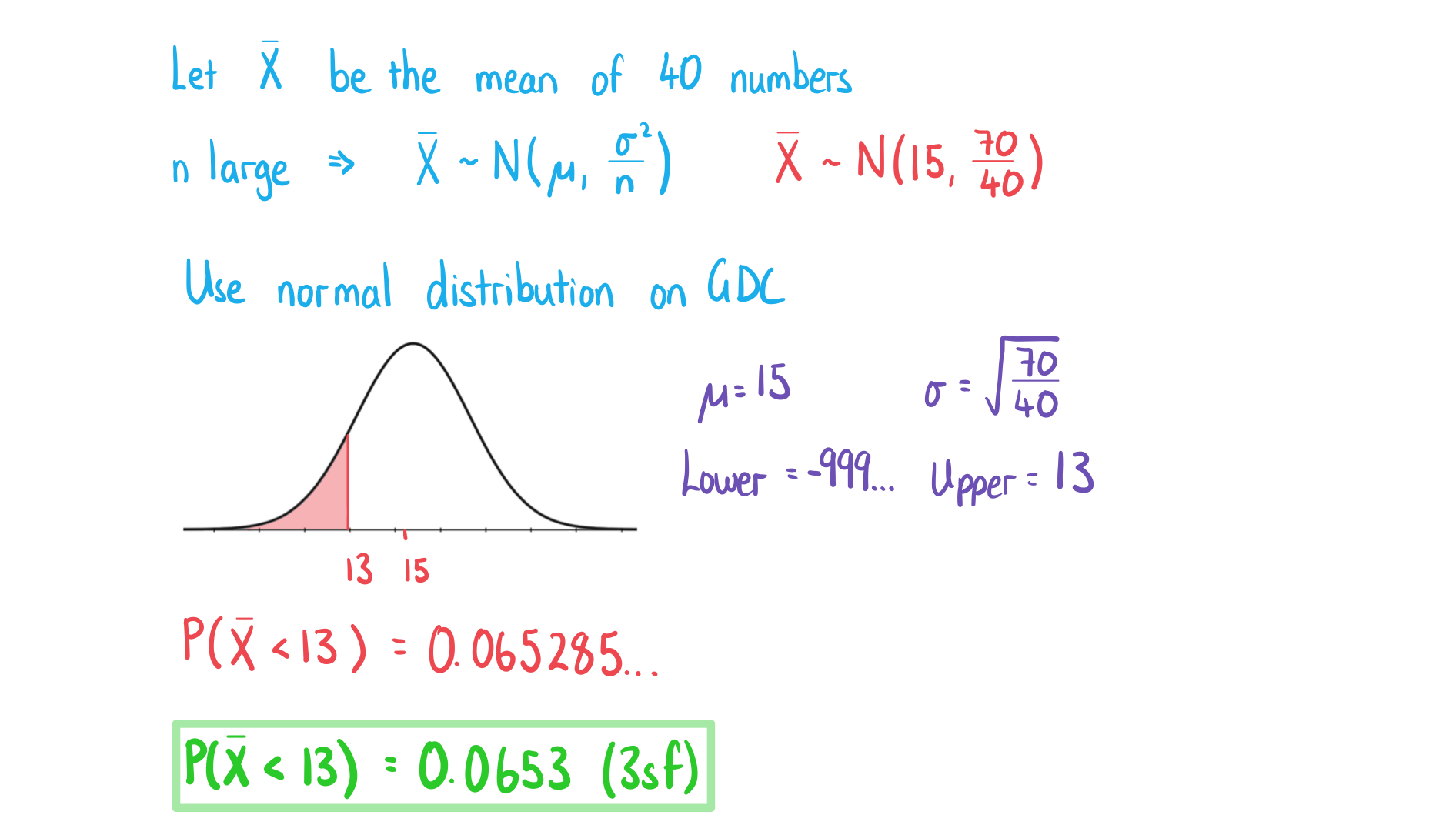Combinations of Normal Variables
What is a linear combination of normal random variables?
- Suppose you have n independent normal random variables
for i = 1,2,3, ..., n
- A linear combination is of the form
where ai and b are constants
- The mean and variance can be calculated using results from random variables
- The variables need to be independent for this result to be true
- A linear combination of n independent normal random variables is also a normal random variable itself
-
- This can be used to find probabilities when combining normal random variables
-
What is meant by the sample mean distribution?
- Suppose you have a population with distribution X and you take a random sample with n observations X1, X2, ..., Xn
- The sample mean distribution is the distribution of the values of the sample mean
- For an individual sample the sample mean
can be calculated
- This is also called a point estimate
is the distribution of the point estimates
What does the sample mean distribution look like when X is normally distributed?
- If the population is normally distributed then the sample mean distribution is also normally distributed
- Therefore you divide the variance of the population by the size of the sample to get the variance of the sample mean distribution
Worked Example
Amber makes a cup of tea using a hot drink vending machine. When the hot water button is pressed the machine dispenses ml of hot water and when the milk button is pressed the machine dispenses
ml of milk. It is known that
and
.
To make a cup of tea Amber presses the hot water button three times and the milk button twice. The total amount of liquid in Amber’s cup is modelled by ml.
a)
Write down the distribution of  .
.

b)
Find the probability that the total amount of liquid in Amber's cup exceeds 360 ml.

c)
Amber makes 15 cups of tea and calculates the mean format('truetype')%3Bfont-weight%3Anormal%3Bfont-style%3Anormal%3B%7D%3C%2Fstyle%3E%3C%2Fdefs%3E%3Ctext%20font-family%3D%22horizontalbf65417dcecc7f2b0006e%22%20font-size%3D%2213%22%20text-anchor%3D%22middle%22%20x%3D%222.5%22%20y%3D%228%22%3E%26%23x23AF%3B%3C%2Ftext%3E%3Ctext%20font-family%3D%22horizontalbf65417dcecc7f2b0006e%22%20font-size%3D%2213%22%20text-anchor%3D%22middle%22%20x%3D%226.5%22%20y%3D%228%22%3E%26%23x23AF%3B%3C%2Ftext%3E%3Ctext%20font-family%3D%22horizontalbf65417dcecc7f2b0006e%22%20font-size%3D%2213%22%20text-anchor%3D%22middle%22%20x%3D%2210.5%22%20y%3D%228%22%3E%26%23x23AF%3B%3C%2Ftext%3E%3Ctext%20font-family%3D%22Times%20New%20Roman%22%20font-size%3D%2218%22%20font-style%3D%22italic%22%20text-anchor%3D%22middle%22%20x%3D%226.5%22%20y%3D%2220%22%3EC%3C%2Ftext%3E%3C%2Fsvg%3E) . Write down the distribution of
. Write down the distribution of format('truetype')%3Bfont-weight%3Anormal%3Bfont-style%3Anormal%3B%7D%3C%2Fstyle%3E%3C%2Fdefs%3E%3Ctext%20font-family%3D%22horizontalbf65417dcecc7f2b0006e%22%20font-size%3D%2213%22%20text-anchor%3D%22middle%22%20x%3D%222.5%22%20y%3D%228%22%3E%26%23x23AF%3B%3C%2Ftext%3E%3Ctext%20font-family%3D%22horizontalbf65417dcecc7f2b0006e%22%20font-size%3D%2213%22%20text-anchor%3D%22middle%22%20x%3D%226.5%22%20y%3D%228%22%3E%26%23x23AF%3B%3C%2Ftext%3E%3Ctext%20font-family%3D%22horizontalbf65417dcecc7f2b0006e%22%20font-size%3D%2213%22%20text-anchor%3D%22middle%22%20x%3D%2210.5%22%20y%3D%228%22%3E%26%23x23AF%3B%3C%2Ftext%3E%3Ctext%20font-family%3D%22Times%20New%20Roman%22%20font-size%3D%2218%22%20font-style%3D%22italic%22%20text-anchor%3D%22middle%22%20x%3D%226.5%22%20y%3D%2220%22%3EC%3C%2Ftext%3E%3C%2Fsvg%3E) .
.

Central Limit Theorem
What is the Central Limit Theorem?
- The Central Limit Theorem says that if a sufficiently large random sample is taken from any distribution
then the sample mean distribution
can be approximated by a normal distribution
- In your exam n > 30 will be considered sufficiently large for the sample size
- Therefore
can be modelled by
- μ is the mean of X
- σ² is the variance of X
- n is the size of the sample
Do I always need to use the Central Limit Theorem when working with the sample mean distribution?
- No – the Central Limit Theorem is not needed when the population is normally distributed
- If X is normally distributed then
is normally distributed
- This is true regardless of the size of the sample
- The Central Limit Theorem is not needed
- If X is not normally distributed then
is approximately normally distributed
- Provided the sample size is large enough
- The Central Limit Theorem is needed
Worked Example
The integers 1 to 29 are written on counters and placed in a bag. The expected value when one is picked at random is 15 and the variance is 70. Susie randomly picks 40 integers, returning the counter after each selection.
a)
Find the probability that the mean of Susie's 40 numbers is less than 13.

b)
Explain whether it was necessary to use the Central Limit Theorem in your calculation.

